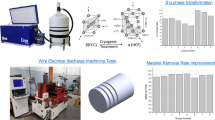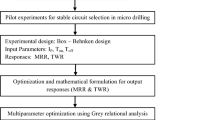Abstract—
Formation of burr at the entry and exit of a hole is a common problem in drilling operations. Especially in drilling of the Ti–4Al–6V alloy, the entry burr is a major concern, which reduces the fatigue life of the components. In this study, Ti–4Al–6V alloy plates were drilled to investigate the effect of electrochemical treatment as well as the machining parameters on the drilling burr formation. Different test pieces were electrochemically treated in an electrochemical cell for time durations from 30 min to 75 min, with the cutting speed and feed rate varying in the range of varying in a range of 100–200 m/min and 0.01–0.05 mm/rev, respectively. As a result of the electrochemical treatment, the hardness was of 621 HV at 10 mN loading for the duration of 60 minutes. Moreover, the hardness was found to be 521 HV at 100 mN loading. Based on the hardness value and SEM micrographs, the 60 minutes electrochemically treated workpiece shows remarkable improvement in the burr formation. The magnified view of the circumference of the drilled hole shows a reduced burr for 60 minutes treated Ti–4Al–6V alloy workpiece.







Similar content being viewed by others
REFERENCES
Dornfeld, D.A., Kim, J.S., Dechow, H., Hewson, J., et al., CIRP Ann. Manuf. Technol., 1999, vol. 48, no. 1, pp. 73–76. https://doi.org/10.1016/S0007-8506(07)63134-5
Cantero, J.L., Tardio, M.M., Canteli, J.A., Marcos, M.M., et al., Int. Mach. Tool Manuf., 2005, vol. 45, no. 11, pp. 1246–1255. https://doi.org/10.1016/j.ijmachtools.2005.01.010
Zhang, P.F., Churi, N.J., Pei, Z.J., and Treadwell, C., Mach. Sci. Technol., 2008, vol. 12, no. 4, pp. 417–444. https://doi.org/10.1080/10910340802519379
Das, K., Eynin, M., and Wretland, A., High Speed Mach., 2017, vol. 3, nos. 1–10, pp. 11–22. https://doi.org/10.1515/hsm-2017-0002
Pecata, O. and Brinksmeiera, E., Proc. CIRP, 2014, p. 13. https://doi.org/10.1016/j.procir.2014.04.001
Patil, R., Shinde, S., Marla, D., and Joshi, S., Int. J. Mechatron. Manuf. Syst., 2016, vol. 9, no. 3, pp. 237–253. https://doi.org/10.1504/IJMMS.2016.079591
Abdelhafeez, A.M., Soo, S.L., Aspinwall, D.K., Dowson, A., et al., Proc. CIRP, 2015, vol. 37, pp. 230–235. https://doi.org/10.1016/j.procir.2015.08.019
Shakeel, A.L., Govindaraju, N., and Pradeep Kumar, M., Mater. Manuf. Process., 2016, vol. 31, no. 5, pp. 603–607. https://doi.org/10.1080/10426914.2015.1019127
Sharif, S. and Rahim, E.A., J. Mater. Process. Technol., 2007, vol. 185, pp. 72–76. https://doi.org/10.1016/j.jmatprotec.2006.03.142
Nithin, T.M. and Vijayaraghavan, L., Mater. Manuf. Process., 2017, vol. 32, no. 2, pp. 199–208. https://doi.org/10.1080/10426914.2016.1176179
Sun, D., Lemoine, P., Keys, D., Doyle, P., et al., Int. J. Adv. Manuf. Technol., 2016, vol. 94, nos. 5–8, pp. 1719–1726. https://doi.org/10.1007/s00170-016-9850-3
Zhu, Z., Sui, S., Sun, J., Li, J., et al., Int. J. Adv. Manuf. Technol., 2017, vol. 93, nos. 1–4, pp. 651–660. https://doi.org/10.1007/s00170-017-0508-6
Skoczypiec, S., Grabowski, M., and Ruszaj, A., Int. J. Adv. Manuf. Technol., 2016, vol. 86, pp. 1873–1880. https://doi.org/10.1007/s00170-015-8320-7
Liu, X., Chu, P.K., and Ding, C., Mater. Sci. Eng., R, 2004, vol. 47, pp. 49–121. https://doi.org/10.1016/j.mser.2004.11.001
ACKNOWLEGMENTS
The authors would like to thank the Nanomaterial Research Lab, Surface Engineering Division, National Aerospace Laboratory, Bangalore, for providing nano-indentation facilities. We are further thankful to the Department of Mechanical Engineering, Government College of Engineering, Salem, for providing SEM facilities.
Author information
Authors and Affiliations
Corresponding author
Ethics declarations
The authors declare that they have no conflict of interest.
About this article
Cite this article
Thanigaivelan, R., Arunachalam, R., Madhan, C. et al. Impact of Electrochemical Passivation on Burr Suppression of Ti–4Al–6V Alloy during Machining. Surf. Engin. Appl.Electrochem. 55, 424–429 (2019). https://doi.org/10.3103/S106837551904015X
Received:
Revised:
Accepted:
Published:
Issue Date:
DOI: https://doi.org/10.3103/S106837551904015X




